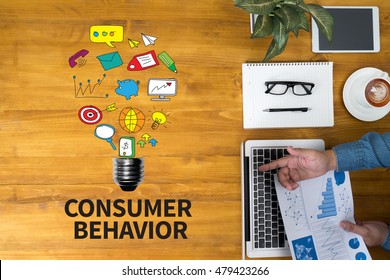Introduction: The Psychology Behind Consumer Behavior
Every day, we make countless decisions—what to eat, what to buy, and even how to spend our time. While it might seem like we’re making logical choices, research in consumer behavior tells a different story. Traditional economics assumes we make rational decisions, but behavioral economics shows that psychological factors, emotions, and subconscious influences play a huge role. These factors shape consumer behavior and are key to understanding consumer behavior and consumer decision-making.
For businesses, knowing what drives consumer behavior is essential. Companies that analyze consumer buying behavior can tailor their marketing strategies to better align with customer needs. Social factors, personal factors, and psychological factors all impact the way people make buying decisions. Factors influencing consumer behavior, such as cultural influences, peer pressure, emotions, and even economic conditions, play a major role in shaping consumer behavior.
To better understand consumer behavior, businesses use different consumer behavior research methods. Surveys, observational studies, data analytics, and AI-driven insights help brands gain deeper insights into buying behavior. This kind of consumer behavior analysis helps businesses refine their marketing strategies and create marketing messages that truly connect with their audience. Learn more about consumer behavior insights.
Technology is also a game-changer in consumer behavior research. With digital tools, companies can track customer behavior in real-time, analyze consumer behavior, and personalize marketing campaigns. Personal factors play a big role in purchasing choices, including lifestyle and income. By using data-driven strategies, businesses can influence consumer behavior and create targeted marketing strategies that drive conversions.
At the end of the day, businesses that understand consumer behavior can shape consumer preferences, boost engagement, and increase sales. As consumer behavior research continues to evolve, companies that stay ahead of the curve will have a major advantage in today’s competitive market. Heres where marketing services play a key role and client can leverage for better insights.
Consumer Behavior: How It Influences Buying Decisions
Consumer behavior drives every buying decision we make. From everyday essentials to big-ticket purchases, many factors influence consumer behavior. Understanding consumer behaviour helps businesses craft marketing strategies that connect with their customers and influence consumer behavior effectively. Let’s take a look at the key factors influencing consumer behavior.
Factors That Influence Consumer Behavior
- Psychological Factors – Consumer decision-making is shaped by psychological factors such as motivation, perception, attitudes, and learning patterns. These factors influence consumer behavior by shaping preferences and determining how individuals respond to marketing messages. Businesses that understand consumer behavior from a psychological perspective can tailor their marketing to influence consumer purchase decisions more effectively.
- Social Factors – Social influence, including peer pressure, family influence, and social status, plays a major role in buying behavior. Consumers often seek validation from their social circles before making a buying decision. Brands that understand consumer behavior in social contexts can leverage social influence, influencer marketing, and user-generated content to shape consumer opinions and drive engagement
- Personal Factors – Age, lifestyle, occupation, and economic status all contribute to consumer behavior. These personal factors influence the types of products and services that appeal to different demographics. Businesses that conduct consumer behavior research can develop marketing strategies that tailor their marketing efforts to specific customer segments, ensuring their marketing messages resonate with the right audience.
- Technology on Consumer Behavior – Digital advancements have transformed consumer behavior. Online reviews, personalized recommendations, and social media all influence consumer behavior. Businesses must adapt their marketing campaigns to align with these digital trends. Data-driven marketing efforts enable brands to influence consumer behavior and create personalized experiences that drive purchase decisions.
- Consumer Behavior Analysis – Businesses rely on consumer behavior research to track shopping patterns, engagement trends, and customer behavior. By analyzing consumer behavior, businesses can anticipate buying decisions, refine marketing messages, and shape consumer perceptions more effectively. Understanding consumer behaviour enables companies to create marketing strategies that optimize product positioning, pricing, and promotional campaigns.
Leveraging Consumer Behavior for Effective Marketing
To implement effective marketing, businesses must tailored their marketing strategies based on consumer behavior research. Companies that understand consumer behavior can design marketing campaigns that influence consumer decision-making and drive customer engagement.
Using consumer behavior research, brands can create compelling marketing messages, refine their marketing efforts, and shape consumer perceptions in a competitive marketplace. By incorporating social factors, personal factors, and psychological factors, businesses can establish deeper connections with consumers. The more companies understand consumer behavior, the more effectively they can optimize their marketing strategies to influence consumer behavior and increase conversions. Learn how to build effective marketing strategies based on consumer behavior.
Loss Aversion & FOMO: How It Influences Consumer Buying Behavior
Ever wondered why sales and limited-time offers make you feel like you need to act fast? That’s loss aversion at work. Studies show that people feel the pain of losing something much more than the joy of gaining it. In other words, losing $100 feels worse than gaining $100 feels good.
Businesses use this psychological factor to influence consumer behavior through FOMO (Fear of Missing Out). When people think they might lose an opportunity, they’re more likely to make purchase decisions faster. This is one of the most effective marketing strategies businesses use to drive immediate purchases.
By recognizing the role of consumer behavior research methods, businesses can adjust their marketing strategies to better align with factors influencing consumer behavior. For example, integrating technology on consumer behavior allows companies to track and predict consumer decision-making, making it easier to create more impactful marketing campaigns.
At the end of the day, the ability to understand consumer behavior and leverage consumer behavior analysis is key to creating compelling marketing strategies that influence consumer behavior and drive lasting engagement.
How Businesses Use Loss Aversion in Marketing
- Limited-Time Offers & Flash Sales – E-commerce giants use countdown timers to create urgency. Seeing a “24-hour flash sale” influences consumer behavior by making shoppers feel like they need to make a quick buying decision.
- Low Stock Alerts – Booking platforms display messages like “Only 2 rooms left at this price!” to shape consumer decision-making and encourage faster purchase decisions.
- Exclusive Membership Benefits – Subscription services highlight the perks non-members are missing, reinforcing exclusivity and influencing consumer behavior to commit to a purchase decision.
- Seasonal & Event-Based Scarcity – Brands introduce limited-edition products or holiday-exclusive sales to influence consumer behavior and create demand through scarcity.
By implementing scarcity-driven marketing efforts, businesses influence consumer behavior to act faster, leading to more conversions and stronger engagement.
Understanding consumer behavior isn’t just about analyzing data—it’s about knowing what drives people to make purchase decisions. When businesses tailor their marketing strategies based on consumer behavior insights, they create effective marketing campaigns that resonate with customers, influence consumer decision-making, and drive long-term success.
Understanding consumer behavior isn’t just about analyzing data—it’s about knowing what drives people to make purchase decisions. When businesses tailor their marketing strategies based on consumer behavior insights, they create effective marketing campaigns that resonate with customers, influence consumer decision-making, and drive long-term success.
How Businesses Use Loss Aversion in Marketing
- Limited-Time Offers & Flash Sales
Online retailers like Amazon, Shopee, and Lazada use countdown timers to indicate when a deal is about to expire. Seeing a “24-hour flash sale” triggers a consumer’s impulse to purchase quickly to avoid missing out. - Low Stock Alerts
Booking platforms such as Agoda and Expedia display messages like “Only 2 rooms left at this price!” to push consumers into making quicker decisions. - Exclusive Membership Benefits
Subscription services like Amazon Prime or airline loyalty programs encourage customers to subscribe by highlighting the perks non-members are missing, reinforcing exclusivity as a motivator. - Seasonal & Event-Based Scarcity
Brands often introduce limited-edition products or holiday-exclusive sales to increase demand. For example, Starbucks’ seasonal drinks or Nike’s limited sneaker drops create anticipation and urgency.
By strategically using scarcity-driven messaging, businesses influence consumer behavior to act faster and commit sooner, increasing conversions and revenue.
Social Proof & the Power of Social Influence on Buying Behavior
Humans are social creatures who tend to follow the crowd, especially in uncertain situations. Social proof is the phenomenon where people assume a behavior is correct based on how others are acting.
How Social Proof Shapes Consumer Behavior
Have you ever bought something just because everyone else was raving about it? That’s social proof in action. When we see other people endorsing a product or service, we naturally trust it more. Social proof plays a massive role in consumer behavior, influencing buying behavior and shaping consumer decisions. Let’s break down how different forms of social influence impact consumer buying behavior.
Customer Reviews & Ratings
Ever checked reviews before making a purchase decision? Platforms like Amazon, Yelp, and Google Reviews have shown that products with higher ratings significantly outperform those with fewer or negative reviews. People trust peer experiences more than advertisements, making online reviews one of the biggest factors influencing consumer behavior.
Influencer Marketing & Brand Endorsements
Social media influencers, celebrities, and industry experts hold significant power over consumer decision-making. Studies show that consumers trust recommendations from people they admire more than traditional advertisements. When influencers promote a brand, it not only increases credibility but also influences consumer behavior by creating a sense of trust and familiarity.
User-Generated Content (UGC)
When consumers see real people using a product, they’re more likely to make a purchase decision. Brands like GoPro and Glossier encourage customers to share photos and videos of their products in action. This kind of content acts as authentic social proof, influencing consumer behavior and boosting customer trust.
Live Sales & Real-Time Testimonials
Platforms like TikTok Shop and Facebook Live have changed the way businesses sell products. Live sales allow brand representatives and influencers to showcase products, answer questions in real time, and provide instant testimonials. This method taps into psychological factors that drive consumer decision-making, making customers feel more confident about their purchases.
By leveraging social proof, businesses can shape consumer behavior, increase trust, and drive higher engagement.
The Psychology Behind Consumer Behavior & Anchoring Effect in Pricing
The anchoring effect is one of the most powerful psychological factors influencing consumer behavior. It refers to how people rely heavily on the first piece of information they receive when making a purchase decision. Businesses use this tactic to influence consumer behavior and shape consumer perceptions of pricing.
Examples of the Anchoring Effect in Marketing
- Original vs. Discounted Price
Have you ever seen an item listed as “Was $299, now $149”? This pricing strategy makes consumers believe they’re getting a fantastic deal, even if the original price was artificially inflated. It influences consumer decision-making by making the new price seem much more attractive. - Decoy Pricing & Tiered Pricing
Companies introduce a “decoy” product to make other options appear more attractive. Apple, for instance, offers three-tier pricing (e.g., basic, pro, and premium), knowing that most consumers will choose the middle option. This strategy shapes consumer behavior by making higher-priced items seem like a better value. - High-Value Product Displays
Luxury brands often anchor consumers to premium prices, making mid-range products appear more affordable. For example, if a designer handbag costs $1,200, a $400 alternative suddenly seems like a bargain. - Subscription Discounts & Annual Pricing
Many SaaS companies offer discounts on annual plans compared to monthly subscriptions. Seeing “Save 20% with an annual plan” creates an anchor that makes the upfront cost seem more economical in the long run.
By setting a reference point, businesses can influence consumer behavior and encourage more strategic buying decisions. Hence, consumer behavior research can play a vital role for businesses.
Consumer Behavior Research Methods & Decision Paralysis
While offering multiple choices may seem like a good idea, too many options can overwhelm consumers. Research shows that when consumers face excessive choices, they struggle with consumer decision-making and may delay or even avoid making a purchase decision altogether. Understanding consumer behavior is crucial for businesses to simplify the buying process and optimize their marketing strategies.
Methods for Studying Consumer Behavior
- Surveys & Questionnaires
Businesses collect direct consumer feedback to understand consumer behavior and identify the factors that influence purchase decisions. Surveys help brands tailor their marketing strategies to meet customer needs. - Observational Research
Tracking customer behavior in physical stores or digital spaces provides real-time insights into how social factors, such as peer influence and brand perception, affect consumer behavior. - Data Analytics & AI
Technology on consumer behavior has transformed the way companies analyze buying behavior. By studying search patterns, engagement trends, and purchase history, businesses can understand personal factors that play a role in consumer decision-making. - Focus Groups & Interviews
Engaging directly with consumers helps brands uncover psychological factors that shape consumer behavior. These interactions reveal deeper emotional motivations behind consumer buying behavior.
By addressing decision paralysis and minimizing excessive complexity, businesses can enhance the overall customer experience and improve consumer purchase decisions. Learn more about how to optimize marketing strategies for better consumer engagement.
Conclusion: Behind Consumer Behavior & Effective Marketing Strategies
Understanding consumer behavior research is no longer optional—it’s essential for businesses looking to stay competitive. From leveraging social proof and psychological factors to using strategic pricing techniques, companies must align their marketing strategies with how consumers think and behave.
Singapore’s startup-friendly ecosystem offers world-class infrastructure, government grants, and access to Southeast Asia’s booming digital economy. But none of that matters if your business doesn’t understand how to connect with consumers and influence their decisions. After you register your business, you will need to understand how you can capture the attention of your target audience.
By tailoring their marketing campaigns to influence consumer behavior, businesses can create persuasive marketing messages that drive conversions. The key is to integrate social influence, personal factors, and psychological factors into every marketing effort, ensuring a seamless and engaging consumer experience.
Brands that truly understand consumer behavior will not only drive sales but also build lasting customer relationships. Effective marketing isn’t just about selling — it’s about shaping consumer behavior, building trust, and creating meaningful connections with customers.





























